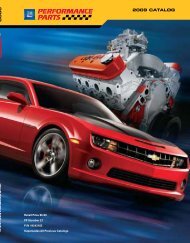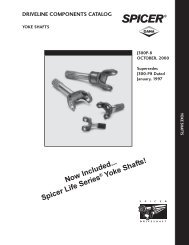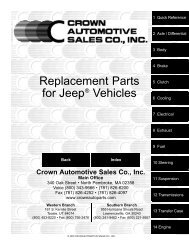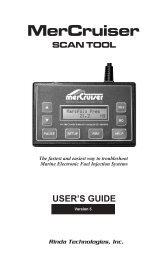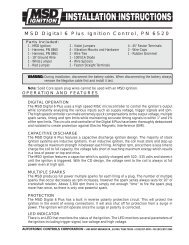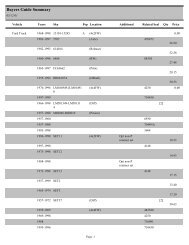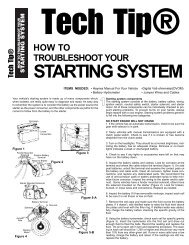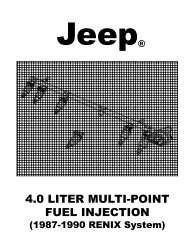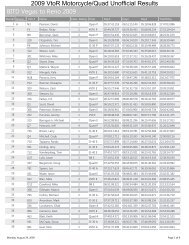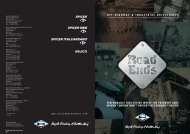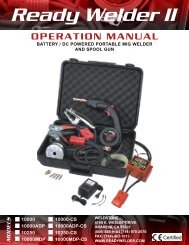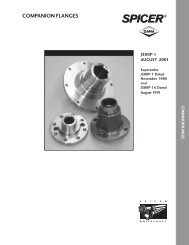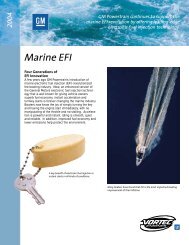Ball and Roller Bearings - Ntn-snr.com
Ball and Roller Bearings - Ntn-snr.com
Ball and Roller Bearings - Ntn-snr.com
You also want an ePaper? Increase the reach of your titles
YUMPU automatically turns print PDFs into web optimized ePapers that Google loves.
Bearing Internal Clearance <strong>and</strong> Preload<br />
8. Bearing Internal Clearance <strong>and</strong> Preload<br />
8.1 Bearing internal clearance<br />
Bearing internal clearance (initial clearance) is the<br />
amount of internal clearance a bearing has before being<br />
installed on a shaft or in a housing.<br />
As shown in Fig. 8.1, when either the inner ring or the<br />
outer ring is fixed <strong>and</strong> the other ring is free to move,<br />
displacement can take place in either an axial or radial<br />
direction. This amount of displacement (radially or axially)<br />
is termed the internal clearance <strong>and</strong>, depending on the<br />
direction, is called the radial internal clearance or the<br />
axial internal clearance.<br />
When the internal clearance of a bearing is measured, a<br />
slight measurement load is applied to the raceway so the<br />
internal clearance may be measured accurately.<br />
However, at this time, a slight amount of elastic<br />
deformation of the bearing occurs under the measurement<br />
load, <strong>and</strong> the clearance measurement value (measured<br />
clearance) is slightly larger than the true clearance. This<br />
discrepancy between the true bearing clearance <strong>and</strong> the<br />
increased amount due to the elastic deformation must be<br />
<strong>com</strong>pensated for. These <strong>com</strong>pensation values are given in<br />
Table 8.1. For roller bearings the amount of elastic<br />
deformation can be ignored.<br />
The internal clearance values for each bearing class are<br />
shown in Tables 8.3 through 8.11.<br />
8.2 Internal clearance selection<br />
The internal clearance of a bearing under operating<br />
conditions (effective clearance) is usually smaller than<br />
the same bearing's initial clearance before being installed<br />
<strong>and</strong> operated. This is due to several factors including<br />
bearing fit, the difference in temperature between the<br />
inner <strong>and</strong> outer rings, etc. As a bearing's operating<br />
clearance has an effect on bearing life, heat<br />
generation, vibration, noise, etc.; care must be taken<br />
in selecting the most suitable operating clearance.<br />
Effective internal clearance:<br />
The internal clearance differential between the initial<br />
clearance <strong>and</strong> the operating (effective) clearance (the<br />
amount of clearance reduction caused by interference<br />
fits, or clearance variation due to the temperature<br />
difference between the inner <strong>and</strong> outer rings) can be<br />
calculated by the following formula:<br />
eff o f t 8.1<br />
where,<br />
eff : Effective internal clearance, mm<br />
o : Bearing internal clearance, mm<br />
f : Reduced amount of clearance due to<br />
interference, mm<br />
t : Reduced amount of clearance due to<br />
temperature differential of inner <strong>and</strong> outer<br />
r, mm<br />
δ<br />
δ1<br />
δ2<br />
Table 8.1 Adjustment of radial internal clearance based on<br />
measured load<br />
Unitm<br />
Nominal Bore Diameter<br />
dmm<br />
over incl.<br />
10<br />
18<br />
50<br />
1<br />
18<br />
50<br />
200<br />
Measuring Load<br />
Nkgf<br />
24.5<br />
49<br />
147<br />
2.5<br />
5<br />
15<br />
Radial Clearance Increase<br />
C2 CN C3 C4 C5<br />
34<br />
45<br />
68<br />
4<br />
5<br />
8<br />
4<br />
6<br />
9<br />
4<br />
6<br />
9<br />
4<br />
6<br />
9<br />
1 This diameter is included in the group.<br />
Radial clearance = Axial clearance =12<br />
Fig. 8.1 Internal clearance<br />
Table 8.2 Examples of applications where bearing clearances<br />
other than normal clearance are used<br />
Operating conditions Applications Selected clearance<br />
With heavy or shock<br />
load, clearance is great.<br />
With direction<br />
indeterminate load,<br />
both inner <strong>and</strong> outer<br />
rings are tight-fitted.<br />
Shaft or inner ring is<br />
heated.<br />
To reduce noise <strong>and</strong><br />
vibration when rotating.<br />
To reduce shaft runout,<br />
clearance is adjusted.<br />
Railway vehicle axles<br />
Vibration screens<br />
Railway vehicle traction<br />
motors<br />
Tractors <strong>and</strong> final speed<br />
regulators<br />
Paper making machines<br />
<strong>and</strong> driers<br />
Rolling mill table rollers<br />
Micromotors<br />
Main spindles of lathes<br />
(Double-row cylindrical roller<br />
bearings)<br />
C3<br />
C3C4<br />
C4<br />
C4<br />
C3C4<br />
C3<br />
C2CM<br />
C9NA<br />
C0NA<br />
A-56



